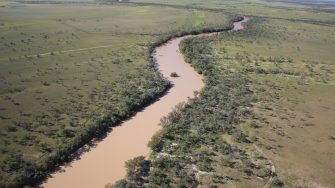
Date: Sunday, October 9, 2016
Project: Eastern Australian Waterbird Survey
Observer: Richard Kingsford
Today we head west to the channel country where we will stop for the night. From Rockhampton, we go south over the Mt Morgan copper mine, long abandoned but with a terrible environmental legacy, polluting the Dee River where the acid water has destroyed aquatic habitat for tens of kilometres downstream.
We soon join survey Band 8, just east of Biloela, which goes east to Baffle Creek, north of Bundaberg. Our first wetland to survey today is the Callide Reservoir, a cooling dam for a coal fired power station. Like most large dams with steep sides in the Great Dividing Range, it only has a few pelicans and cormorants.
Surveying the southern shoreline of Callide Reservoir
Heat is up today but we pick up a bit of a southeasterly wind. It was something to complain about when we were coming east, but now as we are going west, it pushes us along about 10 knots per hour faster. Mostly we dam hop all the way to Emerald where we stop for lunch. We fly west in the middle of the survey band, deviating to survey small dam after small dam, racking up about 40 before lunch. They seldom have more than 10 waterbirds on each but there can be a range of different species from wood ducks, pelicans, cormorants of various species, black duck and even the odd wandering whistling-duck.
Surveying team from inside the plane
We eventually reach a series of small swamps which were about half full, south of the town of Rolleston and east of the Carnarvon Ranges where there were a few black duck, black swans and one had some magpie geese.
Swamps south of Rolleston and just east of the Carnarvon Ranges are only half full, with a range of waterbird species, including magpie geese.
This afternoon’s leg takes us to Windorah to refuel. Our first wetlands are the waterholes along the Barcoo River, one of the main tributaries of Cooper Creek which eventually runs into Lake Eyre. Most years it is bone dry but little waterholes stretch in every direction. Nothing much in the way of waterbirds. Most waterbirds depend on this water reaching the incredibly productive floodplains or lakes, not the waterholes, apart from a few pelicans and comorants.
The Barcoo River joins Cooper Creek; networks of channels intertwine.
The next of the big rivers in the channel country is the Thomson River. Once again, water in its intricate channel system glistens in the afternoon light. The main channel is flowing strongly and it is obvious where the previous floods have gone and the rain has fallen.
The Thomson River is running strongly although secondary channels are not entirely full.
Refuelling in the little town of Windorah on the edge of the Cooper Creek floodplain, means we have to fly over the mighty Cooper with its long waterholes.
One of the main waterholes on Cooper Creek near Windorah
Across the channel country the water that flowed across in all but the main channels has now gone, replaced by sinuous ‘green’ channels, marking parts of the river that got more water and where the plants grow more vigorously on the floodplain.
Even though the floods have passed through the channel country of Cooper Creek, the green swathes are a giveaway to the path of the water, where the plants grow more strongly with their extra water.
Overnight is a treat as we stay with one of my outback friends overnight.
